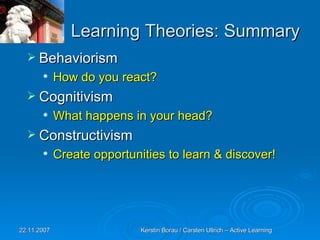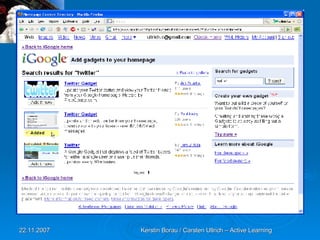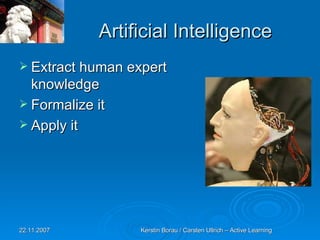Sjtu221107
- 1. Supporting Active Learning and Education by Artificial Intelligence and Web 2.0 Kerstin Borau Carsten Ullrich Photo by Lutz-R. Frank
- 2. Kerstin Borau/ Carsten Ullrich Kerstin Borau Master degree in Applied English Linguistic Certified foreign language teacher. English/German teacher at SJTU Network Education College Research interests: Computer Assisted Foreign Language Learning, new technologies and approaches in Language Learning Carsten Ullrich PhD in Computer Science at Saarland University 2004-2007 researcher at the DFKI (German Research Center for Artificial Intelligence) , one of the largest AI research institutes worldwide Now researcher at E-Learning Lab of SJTU About 50 publications in the area of Artificial Intelligence and Education Research interests: Artificial Intelligence, technology-enhanced learning, Semantic Web, Web 2.0
- 3. Overview Learning Theories Learning Theories and Language Learning Tools for Active Learning Artificial Intelligence for Learner Support
- 5. Timeline of Learning Theories By Serhat Kurt
- 6. Behaviorism (1910) How do you react? Stimulus-Response coupling Psychology should deal with objective, observable subject matter behavior Skinner (1904-1990) The Technology of Learning (1968)
- 7. Behaviorism: Programmed Instruction (1950) Principles: Positively reinforced behavior will reoccur “Praise is good for learning!” Break down complex skills in small bits Teach each bit separately Knowledge is given and absolute
- 8. Programmed Instruction: Example The important parts of a flashlight are the battery and the bulb. When we "turn on" a flashlight, we close a switch which connects the battery with the _______ . bulb When we turn on a flashlight, an electric current flows through the fine wire in the _______ and causes it to grow hot. bulb When the hot wire glows brightly, we say that it gives off or sends out heat and ________ . light
- 9. Test The scientist _______ is one of the fathers of Behaviorism. Skinner The educational technology ________ is based on Behaviorism. Programmed Instruction It is based on ______ correct answers and ____ incorrect answers. Rewarding, punishing Would you like to learn this way? For what subject matters is this appropriate?
- 10. Behaviorism: Summary No explicit treatment of/ interest in mental processes Learner merely responds to the "demands" of the environment Knowledge is viewed as given and absolute
- 11. Learning Theory: Cognitivism What happens in your head? Mental processes are primary object of study Goal: discover and model the mental processes Jean Piaget (1896-1980) Teaching should respect the mental processes
- 12. Learning Theories: Constructivism Behaviorism/Cognitivism get something in the head of the learners Constructivists create opportunities to discover! knowledge: result of individual learning; cannot be transmitted, must be (re)constructed exploration/discovery/group-learning Learner is in control / Teacher is moderator Learning in context and collaboration Solve realistic and meaningful problems
- 13. Learning Theories: Summary Behaviorism How do you react? Cognitivism What happens in your head? Constructivism Create opportunities to learn & discover!
- 14. Behaviorism and language learning Audio-lingual method and audiovisual method focuses on spoken language for everyday communication content: everyday dialogues level: simple exercises: pattern drill
- 15. Behaviorism and language learning Sample Dialoges: 谢谢你! 不用谢! Vielen Dank! Keine Ursache!
- 16. Behaviorism and language learning Advantages: Enables speaking without learning complicated grammar Disadvantages: Pattern drills are boring Restricted language use
- 17. Constructivism and language learning focus: Everything that interests the learners, e.g., own projects content: Everything that interests the learners level: broad level, determined by the topics and the level of the learners
- 18. Constructivism and language learning Advantages: Prepares learners for “real” interaction Disadvantages: None
- 19. Constructivism and language learning How did he learn to play basketball?
- 20. 不闻不若闻之,闻之不若见之,见之不若知之,知之不若行之。 荀子 "Tell me, and I'll forget. Show me, and I may remember. Involve me, and I'll understand“ Xun Zi
- 21. Communicative competence Linguistic aspects • Phonology and orthography (pronunciation & spelling) • Grammar (syntax) • Vocabulary (words) • Discourse (comprehending texts)
- 22. Communicative competence Pragmatic aspects • Functions ( communication purposes ) • Variations (different styles/ appropriate social meaning ) • Interactional skills ( knowing and using the mostly-unwritten rules for interaction in various communication situations ) • Cultural framework ( to understand behavior from the standpoint of the members of a culture)
- 23. Communicative competence How to acquire communicative competence? o Lots of exposure to language you can understand o A chance to negotiate meaning with speakers of the language o A chance to observe and participate in a variety of real communication situations o A chance to get to know what people who speak the language think and believe
- 24. Communicative competence How to acquire communicative competence? o Base structured work on events you participate in such as a shared meal, or working with somebody in the field. o Build basic vocabulary using action-based approaches and games.
- 25. Communicative competence How to acquire communicative competence? o Use your social skills to make relationships. o Spend lots of time doing things with people. o Find creative ways to practice using the language. o Use a lot of communicative activities.
- 26. Tools for Learning: Twitter Twitter: a constructivist approach to acquire communicative competence
- 28. Web 2.0 Twitter: example of Web 2.0 application Web 2.0 applications take full advantage of the network nature of the Web encourage participation inherently social and open Example: Amazon
- 29. Web 1.0 / Web 2.0
- 30. Web 2.0: Some Examples
- 31. Photo by vincos
- 32. Web 2.0 & Learning Web 1.0 Learning: Learning Management Systems Administered learning Teacher/Institution centered Web 2.0 Learning: Student centered Student contribute/communicate Teacher moderates/creates learning opportunities
- 33. Personal Learning Environment Use Web 2.0 applications to create your own learning environment for language learning In 10 minutes! Done
- 50. PLE: Too Much Work? 10 minutes ok But let’s do it in 10 seconds Done
- 54. PLE: Additional Support PLE may be confusing for new learners how to master the tools when to use which tool what tools are available That is where the teacher comes in has knowledge of tools and how to use them Artificial Intelligence implement this knowledge in the computer
- 55. Learning Supported by Artificial Intelligence
- 56. Traditional books/courses: one size fits all non-adaptive ignores your knowledge & goals Adapt learning materials (course) with respect to individual variables (learning goals, knowledge, emotions, …) context (location, device, …)
- 57. Artificial Intelligence Extract human expert knowledge Formalize it Apply it
- 58. AI Supported Learning What does the computer need to know? Domain/Content Model User Model Teaching/Pedagogical Model
- 59. Course Generation: Motivation Eva wants to learn about calculus: “ derivative ” Web-search: Google
- 60. Motivation: Results of Web-Search too many results all kinds of resources not adapted to individual capabilities and goals
- 61. Motivation: Course Generation (CG) Repository “ derivation”
- 62. Motivation: Course Generation Repository “ derivation” Course Generator
- 63. Resources from Several Repositories Repositories “ derivation” Course Generator
- 64. Integration of Learning-Supporting Tools Course Generator Repositories “ derivation” Tool Tool Tools
- 65. CG as a Service Repositories “ derivation” Course Generator Tool Tool Tools
- 66. Modeling of Pedagogical Knowledge / Adaptivity Repositories “ derivation” Course Generator Discover “derivation” Train Competencies “derivation” Exam Simulation “derivation” Illustrate “derivation” Motivate “derivation” Tool Tool Tools
- 67. Course Generation: Pedagogical Knowledge
- 68. Course Generation: Framework AI: planning, multi agent systems, expert systems (HTN) planning: Goal directed Hierarchical approach easily understandable Efficient
- 69. Basics of Hierarchical Task Network Planning How it plans: methods decompose tasks down to primitive tasks performed by operators
- 70. Basic Knowledge Inserting references to educational resources tools Generating structure Accessing information about educational resources the learner About 70 rules
- 71. Example / Exercise Selection About 60 methods Take into account competency level educational level fields of interest novelty motivation & anxiety
- 72. Exercise Selection Selecting an exercise, high motivation (learnerProperty hasMotivation ?c ?m) (>= ?m 4) (learnerProperty hasField ?field) (learnerProperty hasEducationalLevel ?el) (learnerProperty hasCompetencyLevel ?c ?cl) (equivalent (call + 1 ?cl) ?ex_cl) Selecting an exercise, adequate competence level (learnerProperty hasField ?field) (learnerProperty hasEducationalLevel ?el) (learnerProperty hasCompetencyLevel ?c ?cl) (equivalent ?cl ?ex_cl)
- 73. Exercise Selection (:method (trainWithSingleExercise! ?c) ((learnerProperty hasMotivation ?c ?m) (>= ?m 4) (learnerProperty hasField ?field) (learnerProperty hasEducationalLevel ?el) (learnerProperty hasCompetencyLevel ?c ?cl) (equivalent (call + 1 ?cl) ?ex_cl) (assign ?unsortedExercises (call GetResources ((class Exercise) (relation isFor ?c) (property hasLearningContext ?el) (property hasCompetencyLevel ?ex_cl) (property hasField ?field)))) (sortByAlreadySeen ?exercises ?unsortedExercises) (assignIterator ?exercise ?exercises)) ((insertWithVariantsIfReady! ?exercise ?c)))
- 74. Formalized CG Knowledge: Scenarios Moderate constructivist scenarios: Discover Rehearse Connect Train Intensively Train Competencies Exam Simulation Based on guidelines of instructional design Guided Tour ≈ 300 methods and operators
- 75. Scenario “Discover” (discover deriv) (:method (discover ?f) () ((!startSection Discover ?f) (descriptionScenarioSection ?f) (learnFundamentalsDiscover ?f) (reflect ?f) (!endSection))) (:method (learnFundamentalDiscover ?c) () ((!startSection Title (?c)) (introduceWithPrereqSection ?c) (developFundamental ?c) (proveSection ?c) (practiceSection ?c) (showConnectionsSection ?c) (!endSection))) Introduce Develop Prove Practice Connect
- 76. Scenario “Discover” (:method (introduceWithSection! ?c) () ((!startSection Introduction (?c)) (text Introduction (?c)) (motivate! ?c) (problem ?c) (insertIntroductionExample ?c) (!endSection))) (:method (introduceWithPrereqSection! ?c) () ((introduceWithSection! ?c) (learnPrerequisitesFundamentalsShort ?c))) (introduceWithPrereqSection! deriv) Introduce Develop Prove Practice Connect Motivate Problem Illustrate Prerequisites
- 77. Scenario Discover (:method (motivate! ?c) ((learnerProperty hasEducationalLevel ?el) (learnerProperty hasAnxiety ?c ?an) (?an <= 2) (GetElement ((class Exercise) (class Introduction) (relation isFor ?c) (property hasLearningContext ?el) (property hasDifficulty very_easy)))) ((insertAuxOnceIfReady! ?element))) Introduce Develop Practice Connect Reflect Motivate Problem Illustrate Prerequisites
- 80. Course Generation: Results Average time for course generation (filled cache, no LM, complete expansion): 1/37/6 4/105/19 8/262/36 12/254/52 20/365/83
- 81. Course Generation: Results 1/37/6 4/105/19 8/262/36 12/254/52 20/365/83
- 82. AI-Supported Learning: Summary Artificial Intelligence to select learning objects to select tools Does not replace teacher but helps him/her Current research question: How to use AI for Web 2.0
- 83. Summary Learning Theories Learning Theories and Language Learning Tools for Personalized Learning How AI supports your Learning
- 84. How to Continue Contact us for any question: [email_address] [email_address] Use the personal learning environment we created during the lecture: http:// www.google.com/ig/sharetab?hl = en&source = stb&stid =112236995533256220287916fa6930de17d7449a322608f0e32e3 Even better: visit iGoogle and build your personal learning environment http:// www.google.com/ig?hl =en Read and comment the slides: http://www.slideshare.net/ullrich/ Create an account on Twitter http://twitter.com our Twitter names: kerstinlaoshi & ullrich




















































































![How to Continue Contact us for any question: [email_address] [email_address] Use the personal learning environment we created during the lecture: http:// www.google.com/ig/sharetab?hl = en&source = stb&stid =112236995533256220287916fa6930de17d7449a322608f0e32e3 Even better: visit iGoogle and build your personal learning environment http:// www.google.com/ig?hl =en Read and comment the slides: http://www.slideshare.net/ullrich/ Create an account on Twitter http://twitter.com our Twitter names: kerstinlaoshi & ullrich](https://image.slidesharecdn.com/sjtu221107-1195783661631199-4/85/Sjtu221107-84-320.jpg)